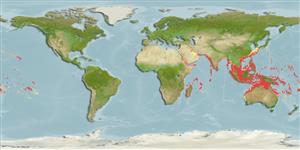>
Eupercaria/misc (Various families in series Eupercaria) >
Lutjanidae (Snappers) > Lutjaninae
Etymology: Lutjanus: Malay, ikan lutjan, name of a fish.
More on author: Forsskål.
Environment: milieu / climate zone / depth range / distribution range
Sinh thái học
Biển Cùng sống ở rạn san hô; Mức độ sâu 1 - 150 m (Ref. 9710). Tropical; 35°N - 33°S, 31°E - 134°W (Ref. 55)
Indo-Pacific: Red Sea and East Africa to the Line and Society islands, north to southern Japan, south to Australia.
Length at first maturity / Bộ gần gũi / Khối lượng (Trọng lượng) / Age
Maturity: Lm 21.5 range ? - ? cm
Max length : 56.8 cm FL con đực/không giới tính; (Ref. 125599); common length : 45.0 cm TL con đực/không giới tính; (Ref. 5450); Khối lượng cực đại được công bố: 2.8 kg (Ref. 125599); Tuổi cực đại được báo cáo: 18 các năm (Ref. 2293)
Các tia vây lưng cứng (tổng cộng): 10; Các vây lưng mềm (tổng cộng): 13-14; Tia cứng vây hậu môn 3; Tia mềm vây hậu môn: 8. This species is distinguished by the following characters: body moderately deep; greatest depth 2.2-2.5 in SL; preopercular notch and knob well developed; vomerine tooth patch crescentic, without a medial posterior extension; gill rakers of first gill arch 9-10 + 115-20 = 25-30 (including rudiments); caudal fin distinctly forked with rounded lobes. Colour red to greyish, an orange hue on lower part of opercle and in pectoral fin axil; fins red (pectoral fins) or usually dark brown to blackish; soft part of dorsal fin, anal and caudal fins with a narrow white margin; juveniles with a large round black spot at base of caudal fin (Ref. 9821, 90102).
Adults mainly inhabit coral reefs, sometimes forming large aggregations, which are mostly stationary during the day. Juveniles occur in seagrass beds, also in mixed sand and coral habitats of shallow sheltered reefs (Ref. 1602). Sub-adults commonly form very large schools that are stationary or drift slowly along slopes during the day. Large individuals along coastal slopes at moderate depths (Ref. 48635). Benthopelagic (Ref. 58302). Feed on fishes, and a variety of invertebrates including shrimps, crabs, lobsters, stomatopods, cephalopods, echinoderms and ophiuroids (Ref. 55). Caught mainly with handlines, traps, and gill nets. Commonly sold fresh. Sometimes causes ciguatera poisoning, particularly around the Pacific islands (Ref. 9821).
Off East Africa spawning occurs mainly during spring and summer.
Allen, G.R., 1985. FAO Species Catalogue. Vol. 6. Snappers of the world. An annotated and illustrated catalogue of lutjanid species known to date. FAO Fish. Synop. 125(6):208 p. Rome: FAO. (Ref. 55)
IUCN Red List Status (Ref. 130435)
Threat to humans
Reports of ciguatera poisoning (Ref. 9710)
Human uses
Các nghề cá: Tính thương mại; cá để chơi: đúng; Bể nuôi cá: Bể cá công cộng
Các công cụ
Special reports
Download XML
Các nguồn internet
Estimates based on models
Preferred temperature (Ref.
123201): 24.5 - 29.1, mean 28 °C (based on 2228 cells).
Phylogenetic diversity index (Ref.
82804): PD
50 = 0.5000 [Uniqueness, from 0.5 = low to 2.0 = high].
Bayesian length-weight: a=0.01549 (0.01389 - 0.01727), b=2.97 (2.95 - 2.99), in cm total length, based on LWR estimates for this species (Ref.
93245).
Mức dinh dưỡng (Ref.
69278): 4.1 ±0.3 se; based on diet studies.
Thích nghi nhanh (Ref.
120179): Trung bình, thời gian nhân đôi của chủng quần tối thiểu là 1.4 - 4.4 năm (K=0.31-0.40; tmax=18).
Prior r = 0.57, 95% CL = 0.37 - 0.85, Based on 1 stock assessment.
Fishing Vulnerability (Ref.
59153): Moderate vulnerability (36 of 100).
Climate Vulnerability (Ref.
125649): High vulnerability (63 of 100).
Nutrients (Ref.
124155): Calcium = 31.8 [20.8, 43.7] mg/100g; Iron = 0.323 [0.211, 0.482] mg/100g; Protein = 18.6 [17.1, 19.9] %; Omega3 = 0.148 [0.108, 0.199] g/100g; Selenium = 72.2 [50.0, 100.4] μg/100g; VitaminA = 137 [26, 492] μg/100g; Zinc = 0.406 [0.333, 0.555] mg/100g (wet weight); based on
nutrient studies.
